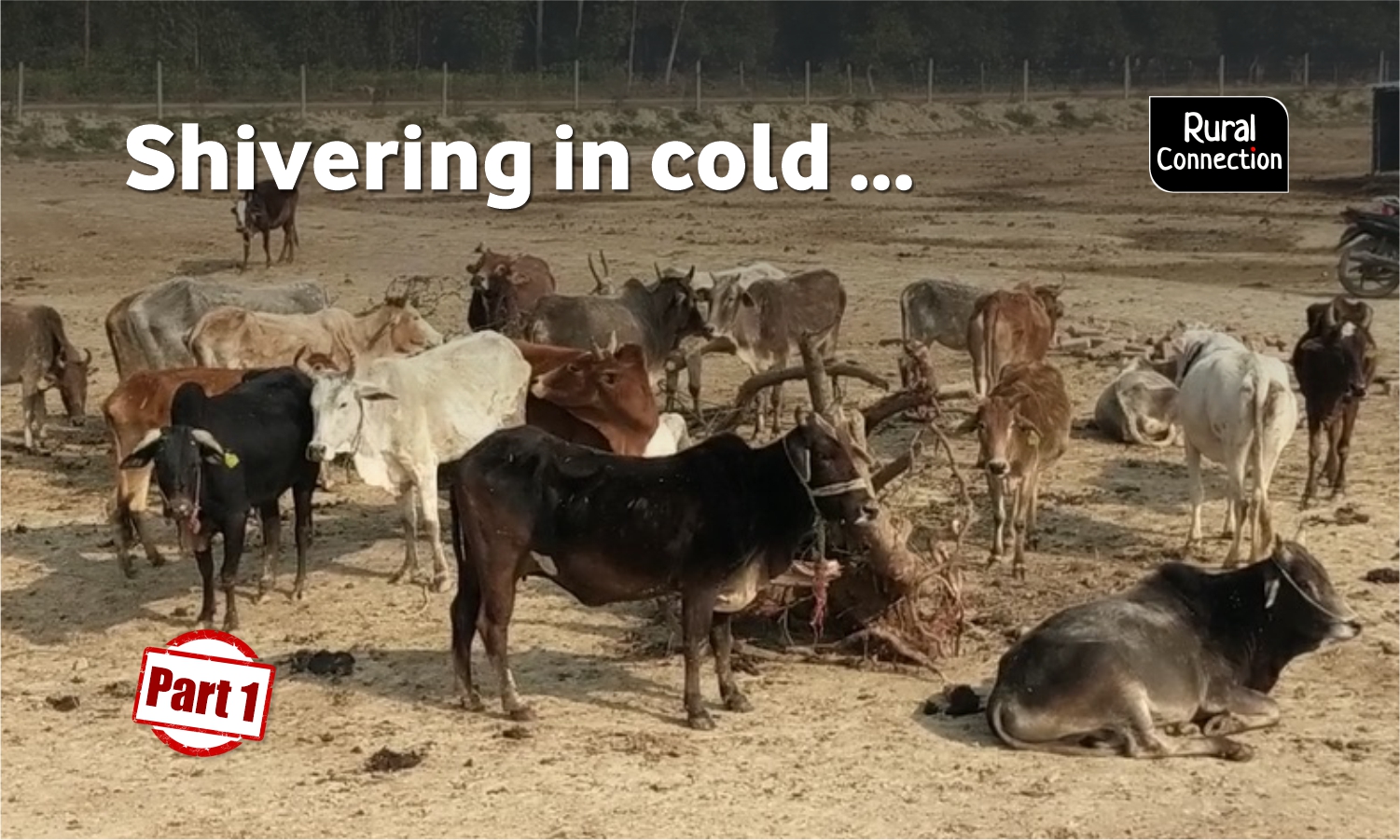Ranvijay Singh/ Diti Bajpai
It was a winter morning and the fields were shrouded in fog. Mercury had dipped to 4-6 degrees celsius and in such a state, more than 75 animals were shivering in cold. These animals were housed in a cow shelter situated out in the open, on the outskirts of the village. A little emaciated, the cattle had been soaking in the night-long dew and stood shrunk due to cold.
Such was the scene in the temporary cow shelter in Dasdoi village of Kakori block, about 30 kms from Uttar Pradesh’s capital Lucknow. While it was being said earlier that the cattle would be provided coats to ward off cold, no particular arrangement was seemingly made at the said cow shelter. Let alone coats, the animals did not even have jute sacks covering their backs.
This is not the only outfit where the cattle have to bear the brunt of cold, most of the cow shelters fare equally poor. As per the statistics of the Animal Husbandry Department, there are 4,954 temporary cow shelters in Uttar Pradesh that house around 4.20 lakh animals. However, from time to time, there are reports that the state of cattle kept here is deplorable. So, when it was known that the cows in Ayodhya would be stitched coats for the winter, the Rural Connection team surveyed certain cow shelters and reviewed their state.
When the Rural Connection team visited the cow shelter in Dasdoi village, it did not see any particular arrangement made to protect the animals against cold. Although small bonfires were lit, they were not adequate. When cow shelter attendant Ramesh was questioned regarding the poor arrangement, he got offended and lashed back: “Who cares for the cows while men freeze of the cold?”
When he was explained that it was not he who was been spoken against, he agreed to talk. Ramesh informed: “The cow shelter has full arrangement from fodder to bonfires.” He, however, had no reply as to why there wasn’t any covering upon the animals. He simply mumbled that how it could be provided if they receive no funds.
Dr AK Singh, joint director (Godhan) of Uttar Pradesh’s animal husbandry department, said: “We are working towards improving the state of bovine shelters. Bonfires are lit to keep the animals warm. Indeed, there are shortcomings which are being attended to.”
In order to fully understand the mismanagement of the cow shelters, one must know as to why the Uttar Pradesh government needed to open up cow shelters at all. In 2017, when the Yogi Adityanath government came to power in Uttar Pradesh, it had expressed its commitment towards cow protection. Under this, it had carried out the closure of illegal butcheries on a large scale, throughout the state. Due to this, the cows were spared and they began roaming everywhere as strays. The farmers in the villages began keeping nightly vigil over their fields for fear of the stray animals eating up their crops.
The animal husbandry department had conducted a survey regarding the population of stray animals as per which Uttar Pradesh was said to have about 7 lakh strays. The rise in stray population and the farmers’ difficulty due the strays prompted the Uttar Pradesh government to establish temporary cow shelters in 2019 to house the animals. So, 4,954 temporary cow shelters came up throughout the state.
After Dasdoi cow shelter, the team moved on to Bhatau Jamalpur, situated 5 kms away. Here too, a temporary cow shelter was made where the team met up with its operations in charge, pradhan pati (husband), Sanjay Saini. He complained, “We work tirelessly looking after the animals. Our cow shelter has 319 animals yet we do not get funds from the government. We are obliged to spend out of our pockets. I was fine with the work of pradhan, but now have been reduced to a cowherd by the government.”
The improvements proposed by the government in its order were not seen in the cow shelter at Bhatau Jamalpur. Also, no special arrangements were made to protect the animals from cold. The cow shelter, however, had adequate provision for feed. Sanjay Saini explained: “The government gives Rs 30 towards daily feed of an animal — we have to feed and keep the animal warm within this. How do we feed an animal in this amount?” Sanjay falls silent after his question as if he’d answered many questions with it.
Sanjay’s explanation proved that lack of funds could be a major reason behind cow shelters’ inability to protect the animals from cold. However, when one looks at the budgetary provision made by the Uttar Pradesh government, the charges seem unfounded. Uttar Pradesh government had, for the year 2019-20, set aside Rs 247.60 crore for the bovine upkeep and building cow shelters while providing additional Rs 200 crore towards Kanha goshala and destitute animal shelter scheme.
At the same time, regarding the division of the funds among the districts, Dr Charan Singh Chaudhary, the development and administrative head of the animal husbandry department, said: “From the budget, the state’s 68 districts received Rs 1 crore each while Bundelkhand’s seven districts got Rs 1.5 crore each.” So, it can be understood that the government has made adequate provisions in the budget.
However, despite all the budgetary provisions, the cow shelters are unable to keep the animals warm during the cold season. The health of the animals is also being affected. Pankaj Gupta, the livestock development officer stationed at Kakori Veterinary Hospital informed: “We are mostly facing the problem of low temperature among the animals kept at the cow shelter. If the bonfires and provision of green fodder are maintained, they would keep well. The sheds are temporary and open on all four sides, so the problem of cold aggravates.”


















